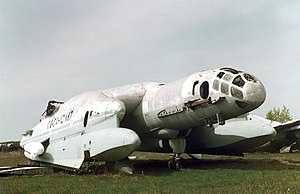avia.wikisort.org - Aeroplane
The Bartini Beriev VVA-14 Vertikaľno-Vzletayushchaya Amfibiya (vertical take-off amphibious aircraft) was a wing-in-ground-effect aircraft developed in the Soviet Union during the early 1970s.[1] Designed to be able to take off from the water and fly at high speed over long distances, it was to make true flights at high altitude, but also have the capability of flying efficiently just above the sea surface, using aerodynamic ground effect. The VVA-14 was designed by Italian-born designer Robert Bartini in answer to a perceived requirement to destroy United States Navy Polaris missile submarines. The final aircraft was retired in 1987.
| VVA-14 | |
|---|---|
 | |
| Survivor in dilapidated condition (wings removed) | |
| Role | Amphibious ASW aircraft |
| National origin | Soviet Union |
| Manufacturer | Beriev |
| Designer | Robert Bartini |
| First flight | 4 September 1972 |
| Retired | 1987 |
| Status | Retired |
| Number built | 2 prototypes |
Development
Bartini, in collaboration with the Beriev Design Bureau intended to develop the prototype VVA-14 in three phases. The VVA-14M1 was to be an aerodynamics and technology testbed, initially with rigid pontoons on the ends of the central wing section, and later with these replaced by inflatable pontoons. The VVA-14M2 was to be more advanced, with two starting engines to blast into the cavity under the wing to give lift and later with a battery of lift engines to give VTOL capability, and with fly-by-wire flight controls. The VVA-14M3 would see the VTOL vehicle fully equipped with armament and with the Burevestnik computerised anti-submarine warfare (ASW) system, Bor-1 magnetic anomaly detector (MAD) and other operational equipment.
Operational history
After extensive research, including the development of the small prototype Be-1 wing in ground effect aircraft, the first VVA-14 prototype was completed in 1972. Its first flight was from a conventional runway on 4 September 1972.[2]
In 1974, inflatable pontoons were installed, though their operation caused many problems. Flotation and water taxi tests followed, culminating in the start of flight testing of the amphibious aircraft on 11 June 1975.
The inflatable pontoons were later replaced by rigid pontoons, while the fuselage was lengthened and the starting engines added. This incarnation was given the designation 14M1P. The bureau supplying the intended battery of 12 RD-36-35PR lift engines did not deliver, and this made VTOL testing impossible.[3]
After Bartini's death in 1974, the project slowed and eventually drew to a close,[2] the aircraft having conducted 107 flights, with a total flight time of 103 hours. The only remaining VVA-14, No. 19172, was retired to the Soviet Central Air Force Museum, Moscow in 1987. As a result of uncertain accidents during the shipping to museum, the aircraft received some damage, but these damages were not repaired afterwards. The aircraft still resides at the museum in a dismantled state, where it carries the designations "10687" and "Aeroflot".[4]
Specifications (VVA-14M1)
Data from [citation needed]
General characteristics
- Crew: 3
- Length: 25.97 m (85 ft 2 in)
- Wingspan: 30 m (98 ft 5 in)
- Height: 6.79 m (22 ft 3 in)
- Wing area: 217.79 m2 (2,344.3 sq ft)
- Empty weight: 23,236 kg (51,227 lb)
- Gross weight: 52,000 kg (114,640 lb)
- Powerplant: 2 × Soloviev D-30M turbofan engines, 67 kN (15,000 lbf) thrust each (Cruise)
- Powerplant: 12 × Rybinsk RD-36-35PR turbofan lift engines, 43 kN (9,700 lbf) thrust each (VTOL - not fitted)
Performance
- Maximum speed: 760 km/h (470 mph, 410 kn)
- Cruise speed: 640 km/h (400 mph, 350 kn)
- Range: 2,450 km (1,520 mi, 1,320 nmi)
- Service ceiling: 8,000–10,000 m (26,000–33,000 ft)
See also
Related development
References
- Russia's Amphibious Aircraft: The Bartini Beriev VVA-14 hague6185.wordpress.com, accessed 27 December 2018
- Dancey, Peter G. (22 April 2017). Soviet Aircraft Industry. Fonthill Media.
-
- Komissarov, Sergey. “Russia's Ekranoplans”. Hinkley. Midland Publishing. 2002. ISBN 1-85780-146-6
- Jacopo Prisco. "The Soviet flying beast that never really took off". CNN. Retrieved 26 August 2021.
- "Bartini VVA-14 Experimental VTOL-amphibian". www.testpilot.ru. Retrieved 28 May 2008.
- "Monino AF Museum". Archived from the original on 3 May 2008. Retrieved 29 May 2008.
- Komissarov, Sergey. “Russia's Ekranoplans”. Hinkley. Midland Publishing. 2002. ISBN 1-85780-146-6
- Komissarov, Sergey and Yefim Gordon. Soviet and Russian Ekranoplans. Hersham, UK: Ian Allan Publishing, 2010. ISBN 978-1-85780-332-7.
External links
На других языках
[de] Berijew WWA-14
Die Berijew WWA-14 (russisch Бериев ВВА-14) oder Bartini WWA-14 ist ein sowjetisches Experimentalflugzeug, das von Berijew gefertigt wurde.- [en] Bartini Beriev VVA-14
[fr] Bartini Beriev VVA-14
Le Bartini Beriev VVA-14 est un avion amphibie soviétique de lutte anti-sous-marine à effet de sol, développé dans les années 1970. Deux prototypes sont construits, dont un est partiellement préservé.[it] Bartini-Beriev VVA-14
Il Bartini-Beriev VVA-14 (in russo: Вертикально-взлетающая амфибия (BBA)?, traslitterato: Vertikal`no-Vzletayuschaya Amphibia (VVA)) fu un rivoluzionario velivolo ibrido, militare e multiruolo, sviluppato in Unione Sovietica durante gli anni settanta su progetto dell'italiano naturalizzato sovietico Roberto Bartini e rimasto allo stadio di prototipo.[ru] ВВА-14
ВВА-14 (вертикально взлетающая амфибия, модификация: экранолёт 14М1П) — экспериментальный советский аппарат (гидросамолёт, бомбардировщик и торпедоносец) конструкции Роберта Бартини, советского авиаконструктора итальянского происхождения. Создавался как аппарат, имеющий возможность взлетать и садиться на воду и как обычный самолёт, и как самолёт вертикального взлёта и посадки. Первый полёт — 4 сентября 1972 года. Из-за сложностей в разработке необходимых двигателей для вертикального взлёта была проведена последняя модификация (14М1П) — превратившая аппарат в экраноплан (1976).Другой контент может иметь иную лицензию. Перед использованием материалов сайта WikiSort.org внимательно изучите правила лицензирования конкретных элементов наполнения сайта.
WikiSort.org - проект по пересортировке и дополнению контента Википедии